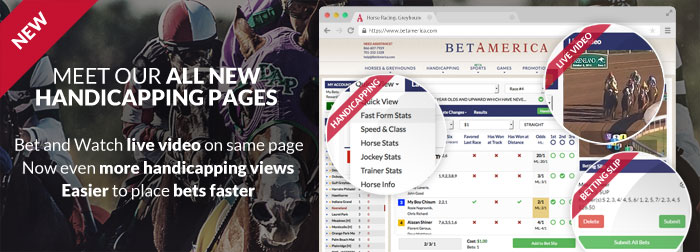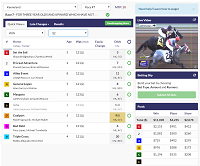New Handicapping Pages View: Quick View

BetAmerica is always finding new ways to make the handicapping experience easier for our players.
How do I access the different handicapping views?
By clicking on the dropdown menu, you can choose from one of seven levels of detail to help you make smarter betting choices.What is the Quick View?
This is the default view the first time you log onto the new handicapping pages. The Quick View gives you the most basic information for you to base your bets off with.How do I use Quick View handicapping view to win?
- Age is helpful if you believe that older horses have more experience and are more inclined to win against their younger counterparts.
- Weight is an interesting piece of information to use because common sense says the lighter the weight on a horse's back, the faster he should run. That's not always the case, but it can be a very helpful tool in weight-for-age or handicap races where the racing office decides a horse has a better chance than his rivals and assigns an impost meant to level the playing field. Also: when a filly or mare runs against the boys, most races are written with a five pound break in the female's favor to even the perceived ability in gender.
- Medication tells you what the horse is running on that day. Most horses in America run on Lasix: formally called Furosemide, a diuretic administered to significantly reduce exercise-induced pulmonary hemorrhage, which is bleeding in the lungs.
- B = Bute, a medication banned on raceday in nearly all jurisdictions
- L = Lasix
- A = Adjunct medication given in conjunction with Lasix and not allowed in all jurisdictions
- C = 1st time Bute
- M = 1st time Lasix, which can be an explanation of a horse's bad performance if they bled last time out and are getting the medication for the first time
- Equipment Change can be the handicapper's best tool: changes in equipment can explain a horse's poor prior efforts or signal a minor the trainer is trying to work around. Fro example: many handicappers think a horse running in a bar shoe is a sign of a trainer trying to manage a horse's sore feat.
- A = Aluminum Pads are a type of shoeing change
- B = Blinkers
- C = Mud Calks are a type of shoe
- F = Front Bandages
- K = Flipping Halter, a device used in the gate primarily with Quarter Horses meant to help calm a nervous horse
- O = Blinkers Off
- R = Bar Shoe is a type of shoe
- V = Cheek Piece, which are fleece pieces that attach to each side of a horse's bridle and act like blinkers without requiring the full hood and cup
